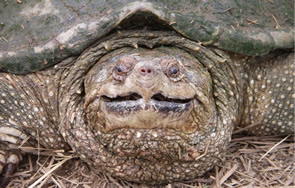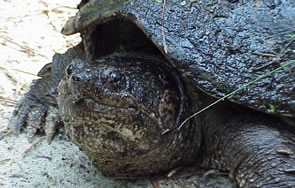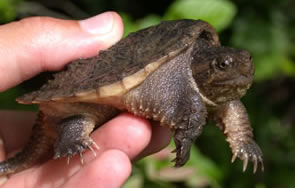
Common Snapping Turtle
Chelydra serpentina
Description: The snapping turtle is the largest freshwater turtle in North Carolina. It has a very large head, a long neck, and a long tail, which is saw-toothed along the top. The carapace (top of shell) is large and varies in color from black to light brown. The plastron (bottom of shell) is small and unhinged. Average length varies from 8 to 14 inches (20.3-36 cm) in carapace length, while weight ranges from 10 to slightly more than 50 lbs. (4.5-22.5 kg).
Feeding/Diet: Snapping turtles are omnivorous. Their diet is varied and includes aquatic invertebrates, fish, reptiles, birds (such as ducklings), mammals, carrion, and aquatic vegetation. They frequently feed on dead or dying animals.
Activity/Behavior: This is one of the most aquatic freshwater turtles found in the state. However, individuals of all sizes can be found on land, especially nesting females. In the water snapping turtles are powerful swimmers, but will frequently walk along the bottom. These turtles rarely bask on logs, but will sometimes “bask” while floating at the water’s surface.
Habitat/Range: Snapping turtles can be found in nearly all permanent water bodies, but they prefer water bodies with soft bottoms and abundant aquatic vegetation. Small individuals can be found in streams. Individuals have also been found in brackish water along the coast.
Reproduction: Snapping turtles lay between 11 and 83 round eggs during the late spring and summer. Females may walk a considerable distance from water to lay their eggs, and are frequently hit by motor vehicles while crossing roads.
Miscellaneous: Snapping turtles get their name from their defensive behavior. Many individuals, especially those taken out of the water, will bite readily with their strong jaws if approached. Snapping turtles are economically important as many are harvested each year for their meat. Studies have shown that commercial harvest of snapping turtles in not sustainable and will result in extirpation of populations.

The shaded region represents the range of the common snapping turtle in North Carolina.





